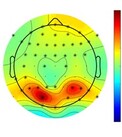Psychology and Neuroscience have traditionally studied the human mind and brain by measuring an organism’s response to external stimuli. Yet humans spend surprisingly little time in this “on task” mode, actively processing information in the immediate environment. We spend nearly a third of our lives sleeping, and even during wakefulness, approximately half of our time is spent mind wandering -- thinking, reminiscing, daydreaming or imagining something other than what we are currently doing. Research in our laboratory concerns the function of these offline states of sleep and rest. It is becoming increasingly clear that the so-called “resting” brain is actually hard at work processing recent experience, integrating new memories into existing semantic networks, and preparing us for the future. Some current projects in the laboratory include:
Memory Consolidation during Resting Wakefulness

Sleep is known to consolidate and enhance previously formed memories. However, under some conditions, resting wakefulness can similarly benefit memory performance. Supported by funding from NIH and NSF, we are exploring the forms of wakefulness which are most beneficial for memory retention, as well as the EEG correlates of this effect.
The Brain Basis of Dreaming
Our research group is also one of a relatively small number of labs conducting rigorous work on the topic of dreaming. The objective of this research is to define the brain processes that create dream experience, which surprisingly, remain almost entirely unknown.
Functional Significance of Alternation between Online & Offline Waking States

Moment-to-moment alternation between online attention to the current environment and offline attention to internally generated thought and imagery may be a fundamental feature of the waking state, occurring even in the absence of a directed cognitive task. Although we all experience such attentional fluctuations throughout the day, the structure and function of these short bouts of offline time remain almost entirely unknown. Our research in this area aims to model the temporal microstructure of wakefulness in human subjects, assessing the functional relevance of fluctuation between "online" and "offline" attentional states.


